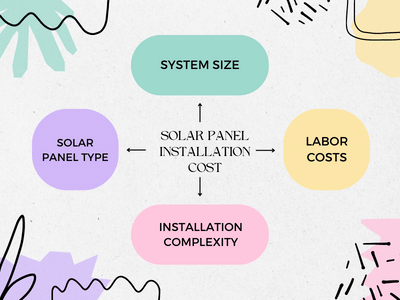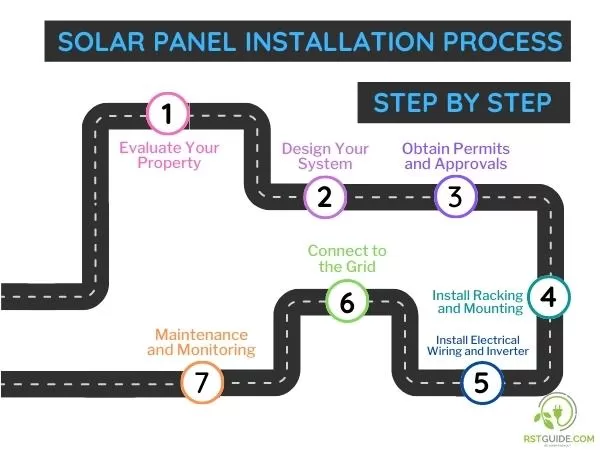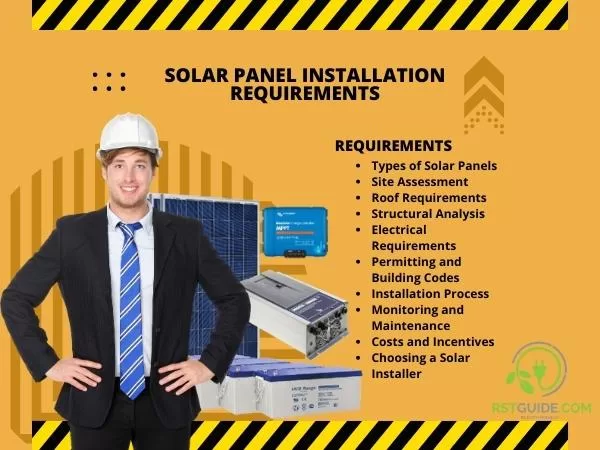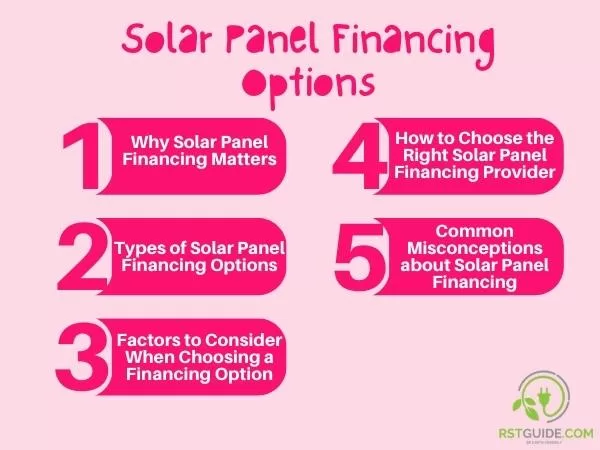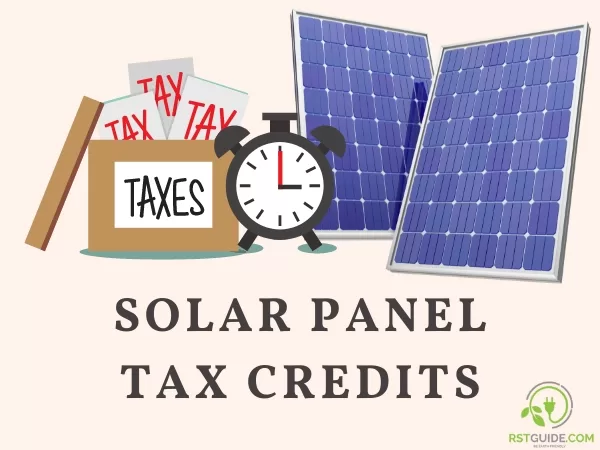Installing solar panels has become increasingly popular as people look for sustainable, cost-effective energy sources. This comprehensive guide will walk you through the process of installing on your property in 2023.
When to Install Solar Panels
The best time to install is during periods of mild weather, such as spring or autumn. Avoid installing them during extreme heat or cold, as these conditions can make installation more challenging and potentially dangerous. Additionally, ensure that your roof is in good condition before installing solar panels to avoid any structural issues.
Safety Considerations for Solar Panel Installation
Before starting the installation process, it is essential to prioritize safety. Keep the following considerations in mind:
- Use proper protective gear, including gloves, safety goggles, and a hard hat.
- Ensure that all electrical work is completed by a licensed electrician.
- Follow manufacturer guidelines for installation.
- Use a fall protection system if working on a sloped or high roof.
- Keep a fire extinguisher handy in case of emergencies.
Essential Tools and Materials
To install, you will need the following tools and materials:
- Solar panels
- Mounting hardware and racking system
- Inverter
- Battery bank (if using an off-grid system)
- Charge controller
- Electrical wiring and conduit
- Disconnect switches
- Grounding equipment
- Tools such as a drill, wrenches, wire strippers, and a ladder
H2: Step-by-Step Instructions for Solar Panel Installation
1. Check for Compatibility
Before purchasing solar panels, make sure your roof is compatible with installation. Check for any structural issues, shading, or obstacles that may impede the system’s efficiency.
2. Select the Right Size
Determine the appropriate size of your solar panel system by evaluating your energy consumption, available roof space, and budget. This will help you decide the number of panels and the size of the inverter you need.
3. Obtain Necessary Permits
Contact your local government to obtain the necessary permits and approvals for your installation. You may need to submit plans, undergo inspections, and adhere to local building codes and regulations.
4. Apply for Incentives and Rebates
Research available incentives and rebates in your area, such as federal tax credits, state rebates, or utility company programs. These can significantly reduce the cost of your system. Make sure to apply for these benefits before starting the installation process.
5. Site Preparation
Before installing , prepare the installation site by:
- Clearing the roof of debris, dirt, and any obstacles.
- Ensuring that the roof structure can support the weight of the solar panels and mounting hardware.
- Marking the positions for the mounting hardware according to your layout plan.
6. Install Racking System
Follow the manufacturer’s instructions to install the racking system, which will support the solar panels. Make sure the racking system is securely attached to the roof and properly aligned.
7. Mount Solar Panels
Carefully lift the solar panels onto the roof and secure them to the racking system according to the manufacturer’s guidelines. Ensure that the panels are properly aligned and securely fastened.
8. Install Heat Sink
If your solar panels require a heat sink, install it according to the manufacturer’s instructions. This component helps dissipate excess heat and prolongs the life of the solar panels.
H3: 9. Set Up Charge Controller
For off-grid systems, install the charge controller between the solar panels and the battery bank. This device regulates the voltage and current flowing from the solar panels to the batteries, preventing overcharging and maximizing battery life.
10. Install Battery Bank
If your system includes a battery bank, install it in a well-ventilated, secure location, following the manufacturer’s guidelines. Connect the battery bank to the charge controller and the inverter.
11. Install Power Inverter
The power inverter converts the direct current (DC) produced by the solar panels into alternating current (AC), which is used by most household appliances. Install the inverter according to the manufacturer’s instructions, connecting it to the solar panels (or the battery bank for off-grid systems) and the main electrical panel.
12. Set Up Energy Meter
An energy meter tracks the electricity generated by your solar panels and consumed by your home. Install the energy meter according to the manufacturer’s guidelines and connect it to the inverter and main electrical panel.
13. Check Electrical Connections
Before connecting the system to the grid, double-check all electrical connections for proper installation and tightness. Verify that the wiring is correct, and the system is properly grounded.
14. Connect to Electrical Panel
With all components installed and checked, connect the system to your home’s main electrical panel. Follow local regulations and guidelines for connecting to the grid. After connection, test the system to ensure it is functioning correctly.
When to Call a Professional
While many aspects of installation can be done by experienced DIYers, some tasks may require the expertise of a professional. Consider hiring a professional if you:
- Are unsure about your ability to safely install.
- Need help obtaining permits or navigating complex regulations.
- Require electrical work beyond your skill level.
Planning Your Home Solar Electric System: Department of Energy Recommendations
The U.S. Department of Energy provides several recommendations for planning your home solar electric system:
1. Assess Your Home’s Energy Efficiency
Before investing in solar energy, evaluate your home’s energy efficiency to ensure you’re using energy wisely. Consider implementing energy-saving measures, such as upgrading insulation, sealing air leaks, and replacing inefficient appliances.
2. Determine Your Solar Potential
Assess your home’s solar potential by considering factors such as roof size, orientation, and shading. A solar site assessment can help determine the best location for your solar panels and estimate the system’s performance.
3. Explore Options for Using Solar Energy
There are several ways to use solar energy in your home:
Purchasing a Solar Energy System
Buy a solar energy system to generate electricity for your home. This option may involve significant upfront costs but can provide long-term savings and energy independence.
Community or Shared Solar
Participate in a community or shared solar program, where you buy or lease a share of a larger solar installation and receive credit on your utility bill for your portion of the energy produced.
Solar Leases
Lease a solar energy system from a solar company. The company installs and maintains the system, and you pay a monthly fee for the electricity it generates.
Power Purchase Agreements (PPA)
Sign a power purchase agreement with a solar company, where you agree to buy the electricity generated by a solar energy system installed on your property at a set price for a specified period.
Solarize Programs
Join a solarize program, which leverages group purchasing power to negotiate lower installation costs and streamline the process for participants.
4. Estimate Your Solar Electricity Needs
Calculate your home’s electricity needs to determine the size of the solar panel system required. Review your utility bills and consult a solar installer for guidance.
5. Obtain Bids and Site Assessments from Solar Installers
Request bids and site assessments from multiple solar installers to compare prices, services, and expertise. This will help you find the best installer for your project.
6. Understand Financing Options and Incentives
Research financing options, such as loans, leases, and power purchase agreements, as well as federal, state, and local incentives that can help offset the cost of your solar energy system.
7. Collaborate with Your Installer and Utility Company
Work closely with your chosen installer and utility company throughout the installation process. Your installer can provide guidance on system design, permitting, and interconnection, while your utility company can help with grid connection and net metering arrangements.
Solar Panel Installation Cost
Factors Affecting Cost
System Size:
The size of the solar system you choose will greatly impact the overall cost. Larger systems generate more power and require more panels, increasing the price.
Equipment:
High-quality panels, inverters, and mounting equipment can have a higher initial cost, but often lead to better performance and longer system life.
Labor Costs:
Installation prices vary depending on the complexity of the project and the location. Professionals usually charge by the watt, ranging from $0.50 to $2.00 per watt.
Permits and Inspections:
These costs vary based on local regulations and may include fees for building permits, electrical permits, and inspection fees. Read More
Solar Panel Installation Process
Site Evaluation
A professional solar installer will visit your property to assess the roof condition, available space, and solar potential. They’ll also evaluate any shading issues and recommend the optimal system size for your needs.
System Design
Once the site evaluation is complete, the installer will design a solar system that meets your energy needs and takes into account any constraints identified during the evaluation.
Permitting and Paperwork
The installer will handle the necessary permits, utility interconnection agreements, and any incentive applications required for your project.
Installation and Inspection
After obtaining the necessary permits, the installation process begins. The installer will mount the panels, connect the wiring, and install the inverter. Once completed, the system will be inspected and tested by local authorities to ensure compliance with building and electrical codes. Read More
Solar Panel Installation Requirements
Roof Condition and Space
Your roof should be in good condition and have enough space to accommodate the solar panels. Flat or south-facing roofs are ideal, as they maximize sun exposure.
Solar Access and Shading
To maximize energy production, your solar system needs unobstructed access to sunlight. Trees, buildings, or other structures that cast shade on the panels can significantly reduce their efficiency.
Local Regulations
Check with your local municipality and homeowners association (if applicable) for any rules or regulations regarding installations. Read More
DIY Solar Panel Installation
Benefits and Drawbacks
A DIY solar panel installation can save you money on labor costs, but it’s important to consider the potential drawbacks. Installing solar panels requires a specific skill set, and any mistakes can lead to decreased efficiency, damage, or even safety hazards. Additionally, you may not have access to the same warranties and support offered by professional installers. Read More
Solar Panel Installation Companies
When choosing a solar panel installation company, research their reputation, experience, and certifications. Read customer reviews, and ask for references from previous clients. Compare quotes from multiple installers to ensure you’re getting the best value for your investment. Read More
Solar Panel Installation Financing
Loans
Many banks and credit unions offer solar loans, allowing you to finance your installation with fixed monthly payments. These loans can cover the entire cost of the system, making it more affordable to get started with solar energy.
Leasing and Power Purchase Agreements
Leasing or entering into a Power Purchase Agreement (PPA) allows you to enjoy the benefits of solar energy without owning the system. In these arrangements, a third party owns and maintains the solar panels on your property, and you pay a monthly fee or rate for the electricity generated by the system. Read More
Solar Panel Installation Tax Credits
The U.S. federal government offers a tax credit to incentivize solar panel installations. Homeowners can claim a percentage of the total installation cost as a tax credit, reducing their overall tax liability. Additionally, many states and local governments offer their own incentives, such as rebates or property tax exemptions. Read More
Solar Panel Installation Guide
Conclusion
Solar panel installation is an investment that can save you money on energy bills, reduce your environmental impact, and increase your property value. By understanding the costs, installation process, requirements, and financing options available in this Solar Panel Installation Guide, you can make an informed decision about whether solar energy is right for your home.
FAQs
How long does it take to install a solar panel system?
Installation times can vary depending on system size and complexity, but most residential installations are completed within 1 to 3 days.
What is the lifespan of a solar panel system?
Typically have a useful life of 25 to 30 years, although they can continue to produce electricity at a reduced efficiency after that time.
How much maintenance do solar panels require?
Require minimal maintenance. Regularly cleaning the panels to remove dirt and debris is recommended, and occasional checks for damage or loose connections are advised.
Can I add more solar panels to my system later?
Yes, you can expand your solar system in the future, provided you have the available space and your inverter can handle the increased capacity.
Do solar panels work during cloudy days or at night?
Produce less electricity on cloudy days but still generate some power. At night, they do not produce electricity since there is no sunlight.
How to Install Solar Panels in 2023?
Solar panel installation in 2023 follows the same general steps as before, including site assessment, permitting, selecting the appropriate equipment, and professional or DIY installation. Technological advancements may streamline the process or introduce new installation methods.
When to Install Solar Panels?
The best time to install solar panels is when your energy consumption is high, and you want to reduce your reliance on the grid. It’s also important to consider seasonal factors, such as installing during the sunnier months for more efficient installation and energy production.
Is solar panel installation right for your home?
Installation is right for your home if you have adequate sun exposure, minimal shading, sufficient space, and a desire to reduce your carbon footprint and energy costs.
How many solar panels are needed to power a house?
The number of solar panels needed to power a house depends on your energy consumption, the efficiency of the panels, and the amount of sunlight your location receives. An average home may require around 20 to 25 solar panels.
What are the different types of solar installations?
There are various types of solar installations, including rooftop, ground-mounted, solar carports, and community solar systems.
How do you install solar panels step by step?
Installation involves multiple steps such as site assessment, obtaining permits, selecting equipment, preparing the site, installing the racking system, mounting solar panels, connecting electrical components, and setting up monitoring systems.
Can you install solar panels yourself?
You can install yourself if you have the necessary skills and knowledge, but it’s generally recommended to work with a professional installer to ensure the system is correctly and safely installed.
How Much Do Solar Panels Cost? (2023 Guide)
The cost of solar panels in 2023 varies depending on factors like system size, location, and installation type. On average, a residential solar panel system can cost between $15,000 and $25,000 before incentives and rebates.
Are solar panels cost-effective?
They are generally cost-effective over their lifetime, as they can significantly reduce or even eliminate your electricity bills, increase your property value, and provide a sustainable source of energy.
How much do solar panels save?
Savings depend on factors like the system size, energy consumption, local electricity rates, and available incentives. On average, a solar panel system can save homeowners between $10,000 and $30,000 over 20-25 years.
What Do Solar Panels Cost and Are They Worth It?
They can be a significant upfront investment, but their long-term savings, environmental benefits, and increased property value make them a worthwhile investment for many homeowners.
How To Save Money Going Solar?
To save money when going solar, research available incentives and rebates, compare quotes from multiple installers, consider a DIY installation, and invest in energy-efficient appliances and practices to maximize solar energy production.
How Do I Pay For Solar Panels?
You can pay for solar panels through various financing options, such as cash, loans, solar leases, power purchase agreements (PPAs), and participating in community or shared solar programs.
What Are the Hidden Costs and Disadvantages of Solar?
Hidden costs and disadvantages of solar can include maintenance, potential roof repairs, the cost of battery storage, and challenges related to shading or suboptimal sun exposure.
When to Call a Pro?
Call a professional solar installer when you need assistance with system design, installation, maintenance, or troubleshooting, or if you lack the necessary skills and knowledge to safely and effectively complete the work yourself.
How to find a solar installer in your area?
To find a solar installer in your area, research online, ask for recommendations from friends or neighbors, read reviews, and request quotes from multiple installers to compare their services, pricing, and expertise.
Where can I purchase solar panels?
You can purchase from various sources, including local solar installers, online retailers, or directly from solar panel manufacturers.
Where to Install Solar Panels?
They should be installed in a location with optimal sun exposure, minimal shading, and enough space to accommodate the desired system size. Common installation locations include rooftops, ground-mounted systems, and solar carports.
What are the different types of solar installations?
The different types of solar installations include grid-tied systems, off-grid systems, and hybrid systems. Grid-tied systems are connected to the utility grid, allowing you to draw electricity from the grid when your solar panels don’t produce enough power. Off-grid systems are not connected to the utility grid and rely on battery storage for power when solar production is insufficient. Hybrid systems combine grid-tied and off-grid elements, often including battery storage to provide backup power during grid outages.
Can you install solar panels yourself?
Yes, you can install yourself, but it requires a solid understanding of electrical systems, building codes, and safety precautions. DIY solar panel installation can save you money on labor costs but may not be suitable for everyone, especially if you lack the necessary skills or tools.
How do you install solar panels step by step?
Here is a general step-by-step guide for installation:
Check for compatibility: Ensure your roof or installation site can accommodate the solar panels and meets structural, shading, and local code requirements.
Obtain necessary permits: Apply for building and electrical permits as required by your local jurisdiction.
Select the right size: Determine the number of solar panels needed based on your energy consumption, available space, and budget.
Site preparation: Clear the installation area, making any necessary repairs or modifications.
Install racking system: Secure the racking or mounting hardware to the installation site.
Mount solar panels: Attach the solar panels to the racking system, ensuring they are properly aligned and secure.
Connect electrical components: Wire the solar panels, inverter, charge controller, and battery storage (if applicable) according to the system design and local electrical codes.
Install a backfeed breaker: Connect the solar system to your main electrical panel through a backfeed breaker, following local code requirements for safe interconnection.
Test the system: Check all electrical connections, confirm proper system operation, and verify that the system is producing power as expected.
Final inspection: Schedule a final inspection with your local permitting authority to ensure code compliance and safe system operation.
How Much Does It Cost to Install Solar Panels Yourself?
The cost of a DIY solar panel installation can vary widely based on factors such as system size, equipment costs, and any additional tools or materials needed. However, DIY installations typically save homeowners between $5,000 and $10,000 on labor costs compared to hiring a professional installer.
What Is the Average Cost to Install Solar Panels Yourself?
The average cost to install yourself can range from $10,000 to $20,000, depending on the system size, equipment, and any additional costs for tools or materials. This cost is typically lower than professional installation, as it does not include labor costs.
What Are the Pros and Cons of DIY Solar Panel Installation?
Pros of DIY solar panel installation include cost savings on labor, the satisfaction of completing the project yourself, and the potential for a faster installation timeline. Cons include the need for a strong understanding of electrical systems, building codes, and safety precautions, potential difficulties obtaining permits and inspections, and the lack of a professional warranty on labor and installation quality.
Where can I purchase solar panels?
You can purchase from various sources, such as online retailers, local solar equipment suppliers, and specialized solar stores. Some popular online retailers include Amazon, Home Depot, and Wholesale Solar. It’s essential to compare prices, warranties, and performance specifications before making a purchase.
Where to Install Solar Panels?
They should be installed in a location that maximizes sun exposure, minimizes shading, and has a suitable structure to support the weight and size of the panels. Common installation sites include rooftops, ground mounts, and solar carports. The ideal installation site will depend on your property’s characteristics, local building codes, and aesthetic preferences.
How much do solar panels cost for homes?
The cost of solar panels for homes can vary depending on factors such as system size, panel efficiency, and installation costs. In general, the cost for residential installations ranges from $15,000 to $25,000 before incentives and rebates. Keep in mind that the cost per watt may decrease as system size increases, making larger systems more cost-effective in some cases.
How much do solar panels save?
They can save homeowners a significant amount on their electricity bills by generating clean, renewable energy. The exact savings will depend on factors such as system size, electricity rates, and solar production. On average, systems can save homeowners between $1,000 and $2,500 per year, depending on the location and energy consumption patterns.
How can I pay for solar panels?
There are several ways to pay for solar panels, including cash, loans, leases, and power purchase agreements (PPAs). Cash purchases typically provide the highest long-term savings but require a significant upfront investment. Solar loans allow you to finance the system and pay it off over time, often with monthly payments similar to or lower than your current electricity bill. Solar leases and PPAs require little to no upfront cost but involve a third party owning and maintaining the system while you pay for the electricity it generates at a predetermined rate.
How much does it cost to install solar panels?
The cost of installing solar panels varies depending on factors such as system size, equipment costs, and labor costs. For a typical residential solar installation, costs can range from $15,000 to $25,000 before incentives and rebates. Professional installation may cost more than a DIY installation due to labor costs but often includes warranties and guarantees on workmanship and system performance.
What are the Pros and Cons of DIY Solar Panel Installation?
DIY installation can save you money on labor costs and potentially allow for a more customized system. However, it also has some disadvantages.
Pros of DIY solar panel installation:
- Lower installation costs
- Customized system design
- Personal involvement in the project
Cons of DIY solar panel installation:
- Lack of professional expertise may lead to mistakes and decreased system performance
- Potential safety risks during installation
- Difficulty obtaining necessary permits and inspections
- Limited or no access to warranties and guarantees on workmanship or equipment
How long do solar panels last?
They typically have a lifespan of 25 to 30 years. However, they do not stop producing electricity after that time; their efficiency and output will gradually decrease. Most of them come with a performance warranty that guarantees a certain level of efficiency (usually around 80%) after 25 years.
What factors impact solar costs?
Several factors impact the cost of installation, including:
- System size: Larger systems require more panels and equipment, increasing costs.
- Panel efficiency: Higher efficiency panels may cost more but can generate more electricity per square foot.
- Labor costs: Professional installation and labor costs vary by region and company.
- Permitting and inspection fees: Local building codes and permit fees can affect the total cost.
- Incentives and rebates: Federal, state, and local incentives can significantly reduce the net cost of solar panel installation.
Related Topics
Solar power
Solar power has become an increasingly popular choice for homeowners looking to reduce their carbon footprint, save on energy costs, and take advantage of various incentives. Installing a solar panel system on your home can provide numerous benefits to both the environment and your wallet. In this article, we will explore some essential aspects of solar panel installation, including the solar tax credit, solar batteries, solar arrays, and rooftop solar systems.
Solar power is a clean and renewable source of energy, making it an environmentally friendly option compared to traditional fossil fuels. By choosing solar power, you are actively contributing to the reduction of greenhouse gas emissions and the conservation of natural resources.
The solar tax credit
The solar tax credit, also known as the federal Investment Tax Credit (ITC), is a significant financial incentive for homeowners who choose to install solar panels. This tax credit allows homeowners to deduct a percentage of their solar installation costs from their federal income taxes. By taking advantage of the solar tax credit, you can significantly reduce the overall cost of your solar panel system, making it more cost-effective and accessible.
Solar batteries
Solar batteries play a crucial role in maximizing the efficiency of your solar panel system. By storing excess energy generated by your solar panels, a solar battery allows you to use solar power even when the sun isn’t shining. This stored energy can help you avoid using grid electricity during peak hours, reducing your energy bills and increasing your system’s overall efficiency.
Solar array
A solar array is a group of solar panels connected to create a larger system capable of generating more electricity. The size of your solar array will depend on your energy needs, available roof space, and budget. Designing an efficient solar array is essential for maximizing the energy production and overall effectiveness of your solar panel system.
Rooftop solar systems
Rooftop solar systems are the most common type of solar panel installation for residential properties. Installing solar panels on your roof allows you to take advantage of unused space while also providing a sleek and unobtrusive appearance. Before installing rooftop solar, it is essential to ensure your roof can support the additional weight and that there are no shading issues that could reduce the efficiency of your solar panels.
Solar panel costs
Solar panel costs have significantly decreased in recent years, making solar power more accessible to homeowners. While the initial investment for a solar panel system may seem high, the long-term savings on energy bills and the various incentives available can offset these costs. It’s essential to consider both the upfront cost and the potential savings when evaluating the financial viability of installing solar panels.
In conclusion, installing a solar panel system can be a smart and environmentally friendly choice for homeowners. By considering factors such as the solar tax credit, solar batteries, solar arrays, and rooftop solar installation, you can make an informed decision about whether solar power is the right choice for your home. With solar panel costs decreasing and the potential for significant long-term savings, now is a great time to explore the benefits of solar power.
